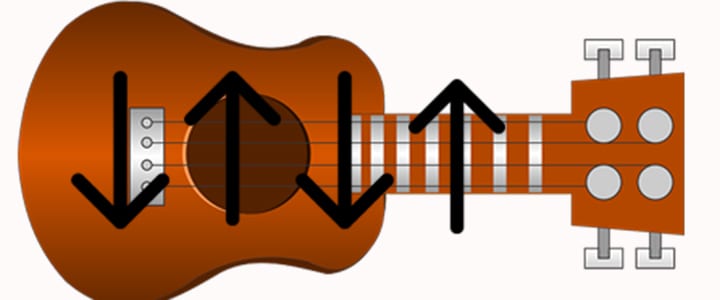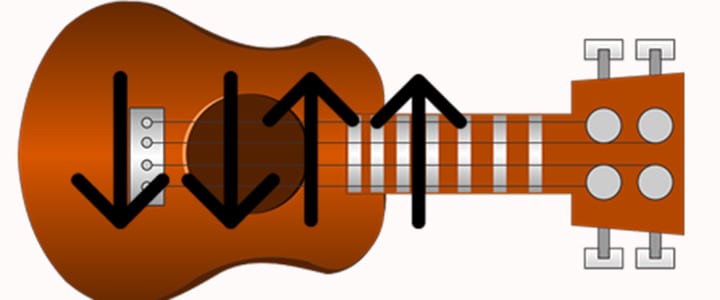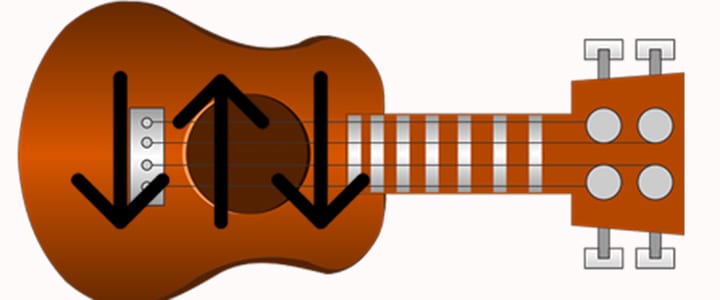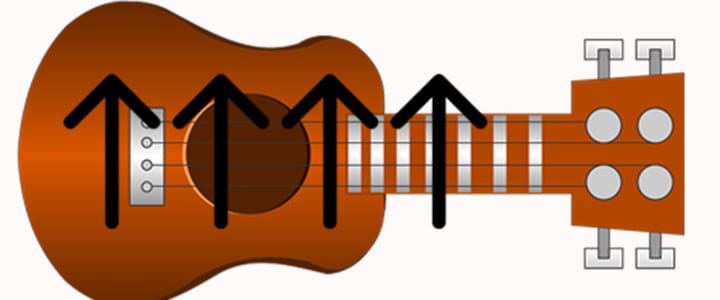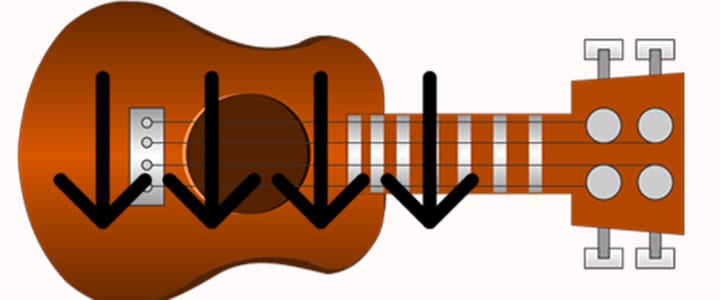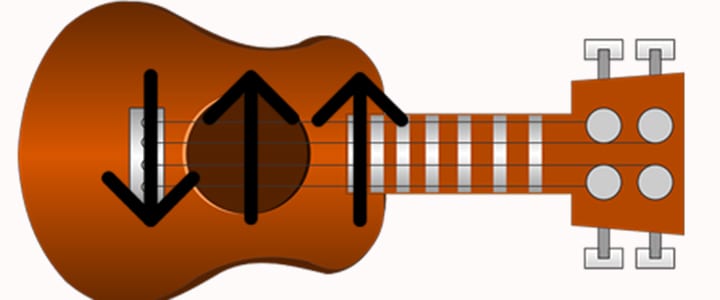No matter where you are in your ukulele lessons, learning different ukulele strumming patterns will help you improve your technique and your sound. Here, ukulele instructor Willy M. goes over some basic strumming and fingerpicking patterns…
Welcome to picking on the ukulele with Willy. In this lesson, we will learn how to insult, berate, sting and verbally abuse your ukulele! Just kidding! We’re going to talk about ukulele strumming patterns. We’ll also cover picking techniques and strumming basics that will help you make beautiful music with your ukulele.
Ukulele Strumming Techniques
One of the first things that people ask with any stringed instrument is: “How do I strum?” This seems like a simple question until you’re actually holding the ukulele in your hands and wondering: “Should I use my thumb? My fingers? Should I use a pick?”
These are important questions, but once you find the answers, you’re hit with even more questions like: “Do I strum fast, or slow, up or down, or down and then up?” Or, “am I supposed to strum only down or only up?” “What about finger picking? How does that work?”
To eliminate confusion, let’s take a look at some of these questions. First, let’s tackle basic strumming technique, then we’ll delve into different ukulele strumming patterns you can try on your own.
Playing the Ukulele With a Pick
I’m a fingerpicker. I started out on the guitar, and then moved to the mandolin and ukulele after learning a lot of my technique on the guitar. So I apply guitar principles to the ukulele. These techniques are actually very helpful, and can keep you from developing bad habits that can hurt your wrists and fingers.
First of all, if you decide to use a pick, you should learn how to hold a pick correctly. Make sure that you don’t hold it too tightly. Your pick should be held firmly between the thumb and the first finger, and your hand should not be cramped up (you don’t need to have a death grip on the pick). In fact, proper technique is to hold the pick with a firmness that you or a friend could gently tug the pick from your fingers, but not so loosely that you will drop the pick when you play.
Now, what type of pick should you use? That all depends on the sound you want to hear. I recommend going to your local music store and purchasing six types of picks. First, buy the thinnest type of pick that they have. Then, buy the thickest one, and then the one in between. Then see if they have a felt pick (if they don’t, they can probably order one for you). You may also want to pick up a set of banjo picks (either metal, plastic, or both). Then after you pay, take a quarter or dime from the change, and add that to your pick collection. Brian May, lead guitarist from the rock band Queen, used an English Pence with a milled edge to get interesting sounds out of the strings.
Give all of these picks a try, and see which ones work for you. This collection of picks should give you plenty to experiment with, and will help you figure out if you like using picks, or if you’d rather do without them and use your fingers.
Fingerpicking
If you’re going to use your fingers, I recommend keeping the fingernails on your fretting hand trimmed. If you want, you can let the ones on your picking hand grow a little longer, or use acrylic nails (like James Taylor and Phil Keaggy). I keep both of my hands trimmed short when I play, and use the pads of my fingers. Try some different things and see what works for you!
When you finger pick, keep your hands loose, and try not to allow yourself to get stressed out as you play. I know that learning something new requires a lot of concentration, but you don’t want to get in the habit of playing stressed; you will experience pain, discomfort, and in extreme cases, develop problems like carpal tunnel syndrome and ulna nerve damage.
Ukulele Strumming Patterns
Once you break it down and think about it, ukulele strumming isn’t that difficult. You have down strums, up strums, and palm-muting techniques. If you apply these three principles, you get a wide variety of rhythmic variation that you can use to play songs.
The key to being a good rhythm player is to learn to strum in time to the music. Practice slowly at first, and then speed up as you get better. Also, try strumming in ways that you think accentuate the beat of the song. Ask yourself: “is what I’m strumming adding to or taking away from the drum section in this song?” If there are no drums, ask yourself: “is my strumming rhythmic and steady, and does it fill in where the drums are missing?”
Palm muting is a fun exercise to practice when you’re strumming. Place the bottom part of your hand across all the strings, lightly. Roll your hand and use your pick to strum across the strings. You should hear a “plunky” sound. This is a common guitar technique that’s used by the Cars and other ’80s rock bands. It sounds very interesting on the ukulele; it gives it a “pizzicato” sound.
Here are some ukulele strumming patterns to help you get started:
Down – Up – Down – Up
This simple pattern is the most basic, and can be strummed to whole notes, half notes, quarter notes, or even eighth and 16th notes. Just consider that each type of note you strum to will either make it sound slower or faster.
When you strum a whole note, you will count to four before you strum the next up whole note. If you’re using eighth notes, you will strum eight times in each measure.
Down – Down – Up
This pattern allows you to rest on the last beat of a four-count measure. Or you can play it as a waltz-time kind of feel.
Down – Down – Up – Up
This is another popular, easy pattern.
Down – Up – Down
This is also called a triplet pattern. Triplets are clever devices that allow you to cram three notes into the space of two!
If you’re repeating this pattern, it will go like this: D – U – D, D – U – D, etc.
Up – Up – Up – Up
This pattern gives you a bright, jumpy sound.
Down – Down – Down – Down
This pattern is the opposite of the last one, and it has a more authoritative beat.
Down – Up – Up
This can be another triplet pattern, or three beats and a rest.
Keep trying various combinations until you find some that work for you.
Ukulele Picking Patterns
Finally, let’s look at ukulele fingerpicking patterns. With these patterns, you don’t need a pick. You can use one if you’d like, but most people throw out the pick and use just their fingers.
Now which fingers should you use? Well, you have four strings, so you probably won’t need your pinky. This leaves you the option to finger pick with your thumb by itself, your thumb and forefinger, your thumb, your forefinger and middle finger, or your thumb, forefinger, middle, and ring fingers.
I personally tend to finger pick with just my thumb and first finger, though occasionally, I will throw in a banjo roll with my first three fingers. You need to try what works for you, but here are a few patterns that you can experiment with to see what feels comfortable.
For these patterns, you should know how to do some basic rolls on the ukulele.
Forward Roll
Place your fingers over the strings (lightly). Use your thumb to control the G and C strings. Use your thumb to alternately pick the G and C.
Use your index finger to control the E string, and use your middle finger for the A string. The pattern goes like this: thumb – index- middle.
Backwards Roll
This is the forward roll in reverse: middle – index – thumb.
For these picking patterns, I will give you the strings and you can try the different fingerpicking methods. You might want to practice these patterns by holding down a chord that you’re familiar with and then picking along.
G, C, E, G, C, E
This is basically a forward banjo roll.
G, G, C, E, A
This is a modification of the forward banjo roll.
C, E, G, A
A four-string variation of a Travis-style roll.
C, C, E, G, C
Another type of Travis roll.
C, C, E, G, A
This is basically a forward roll.
C, C, E, G, A, E, C
A forward-backwards roll.
A, E, C, G
A backwards roll.
A, A, E, C, G, C
Another backwards roll, but ends on the tonic.
G, A, C, A, E, A
Similar to the picking in the classical Spanish song “Malagueña.”
G, A, C, A, C, A, G
This is another variation of the previous pattern.
You can also try these fingerpicking patterns with just your thumb and first finger, or your thumb and middle finger. Then, try them again with your thumb, first finger, and middle finger. Then, try them all again with your thumb, first finger, middle finger, and ring finger.
So there you have it; a bunch of rolls, patterns, fingerings, strums, and rhythms that should help you get started strumming the ukulele!
 Post Author: Willy M.
Post Author: Willy M.Willy M. teaches guitar, ukulele, and mandolin lessons in Winston Salem, NC. He’s the author of the Dead Man’s Tuning series of mandolin songbooks, and is a former member of the American Federation of Musicians. Willy has been teaching for 20 years, and his students have ranged in age from young children to folks in their 80s. Learn more about Willy here!
Photo courtesy WFIU Public Radio
Maile Proctor


